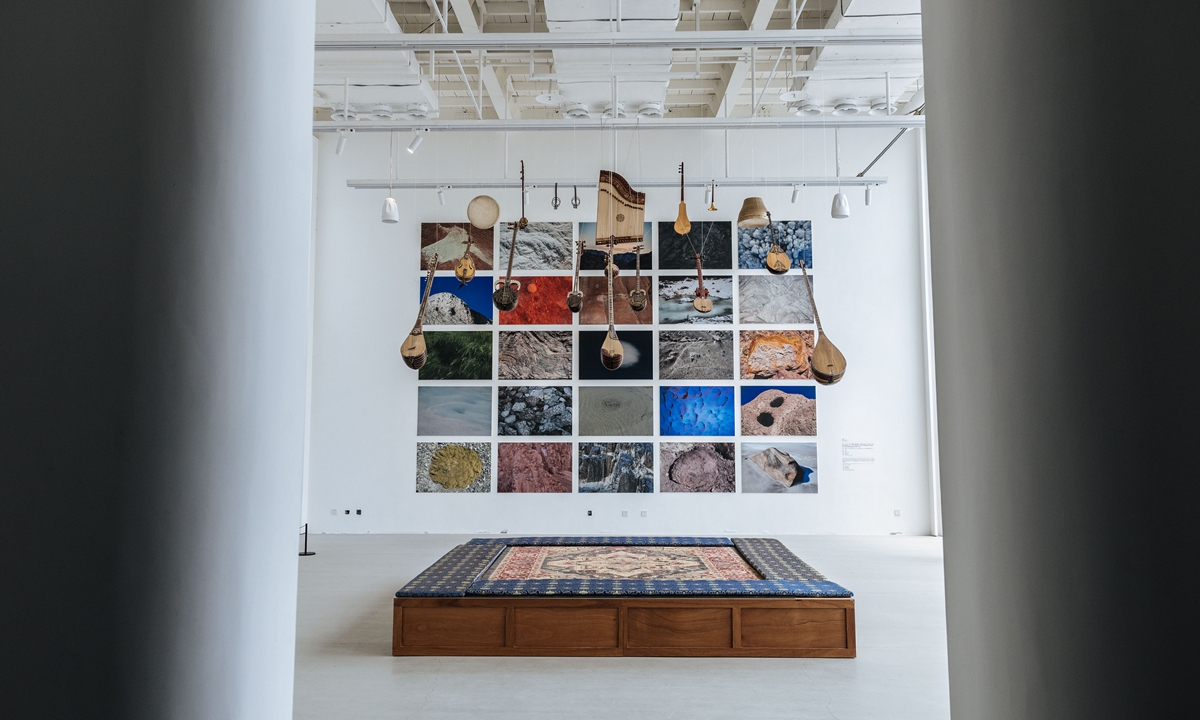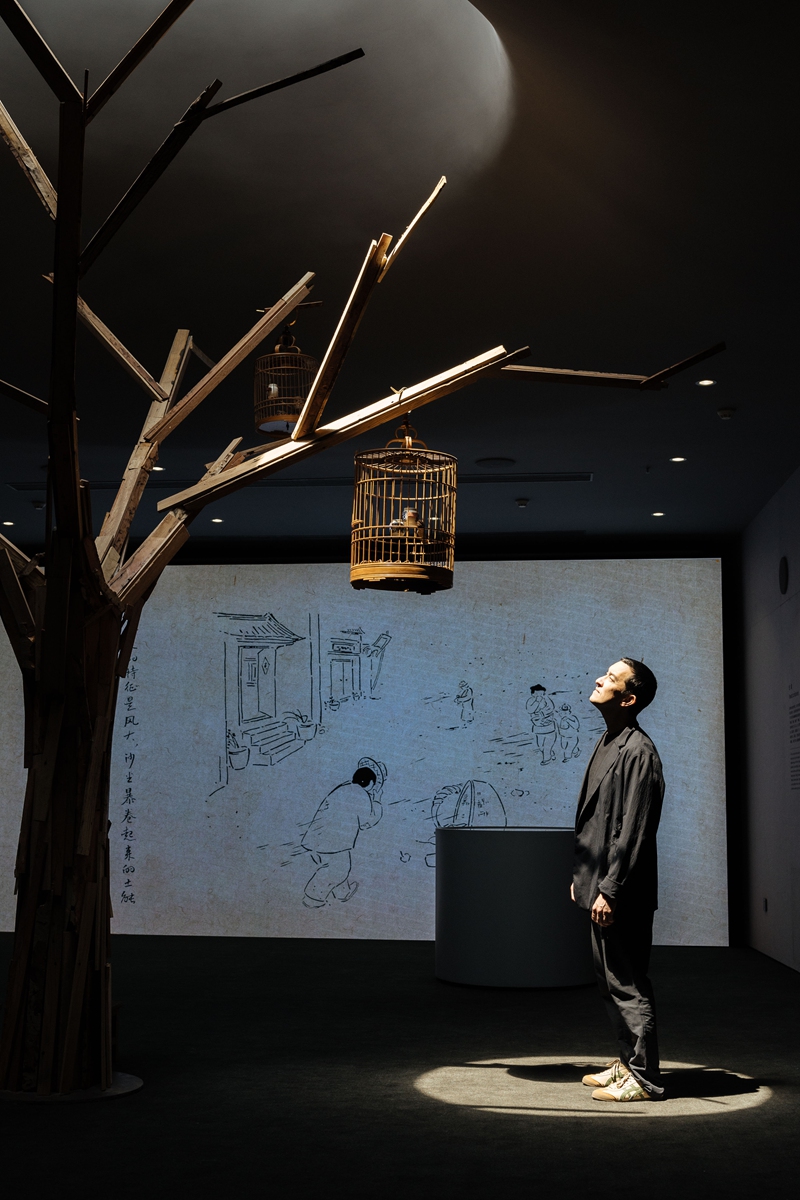
Works on display at the Sound Art Museum in Beijing Photo: Li Hao/Global Times
Every city has its own distinctive soundscape, shaped by its history, culture and people. But as urbanization progresses, many of these auditory treasures fade away.
For Colin Chinnery (Chinese name Qin Siyuan), a Beijing-based contemporary artist with a British background, capturing the sound of old Beijing is a quest of discovery.
At the newly opened Sound Art Museum, Chinnery showcases his auditory portrait of Beijing, the ancient Chinese capital: A city where pigeons whistle in the air, knives clink on grindstones and tricycle peddlers hawk their wares in narrow
hutong (traditional alleyways).
The 52-year-old artist has collected these sounds over the past decade, exhibiting them at the Sound Art Museum, a 6,000-square-meter architectural complex that he co-founded with Chinese philanthropist Hong Feng in Songzhuang, in eastern suburban Beijing. The museum also features natural soundscapes, languages and music from around the world.
"The loss of traditions is inevitable in the course of urbanization," Chinnery told the Global Times in an interview.
"In the West, you might find some traces of these traditions in museums or concert halls, but not on the streets or in the parks. Here in Beijing, you can still encounter some remnants of traditions that are not yet extinct, that are still alive in this society," he noted.
"And I just wanted to preserve them before they are all forgotten with the passage of time," he said.

Beijing-based artist Colin Chinnery poses for a photo at his Sound Art Museum in Beijing on May 24, 2023. Photo: Li Hao/Global Times
Searching the past
The museum greets visitors with the traditional voices of street peddlers echoing in
hutong, inviting them to immerse themselves in the soundscape even before they enter the building.
Street peddlers were a common sight and sound in old Beijing for centuries, before modern modes of commerce took over. Their cries, such as "mojianzi" (sharpen scissors) and "qiangcaidao" (sharpen kitchen knives), may sound unfamiliar to most young people today, but they evoke a nostalgic sense of
hutong life for the older generation of Beijingers.
Recording these voices was one of Chinnery's most memorable projects, he told the Global Times, and many of the Beijing-related works at the Sound Art Museum are based on his previous creations over the past decade.
Chinnery's journey into sound art cannot be separated from his maternal grandmother Ling Shuhua (1900-1990), who lived in a
siheyuan (traditional courtyard house) that later became the famous Shijia Hutong Museum. As Beijing's first public
hutong museum, Shijia Hutong Museum is dedicated to promoting Beijing
hutong culture. Ling was a renowned Chinese writer who was hailed as one of the three most talented women in northern China in the early 20th century, along with another writer Bing Xin and celebrated architect Lin Huiyin.
In The Sound of Old Beijing, the first unit of the exhibition, Chinnery re-creates scenes of everyday life through sounds, text and illustrations, drawing inspiration from his grandmother Ling's illustrations for her autobiographical book about her early life in the late Qing Dynasty (1644-1911).
In 2013, Chinnery's ancestral home was transformed into a museum with support from the Beijing Dongcheng district government and the Prince's Trust of then Prince Charles of the UK.
Chinnery was invited to do an art project to revive the atmosphere of old Beijing, which marked the beginning of his sound art career.
"I proposed the sound art of old Beijing to the [Shijia Hutong] museum because I thought it would be a very interesting project to do."
But the first challenge was to find the sounds, which had to be old but also still around to be recorded.
"To explore Beijing's history through sounds, you need a basis, which has to come from a living person," he recalled.
"And the earliest human sounds that had been kept are from the era of the Republic of China [1912-1949], so that's where my sound history of Beijing started."
InheritancePreserving The Beijing Peddlers sound project features two important figures for Chinnery: Song Zhenzhong, also known as A-long, and Yang Deshan, who was the last Beijing peddler in history before he passed away several years ago.
A-long, Chinnery's partner in the project, organized all the peddling sounds into a system that can be performed and used for education. He also collected all the rattles from the merchants, the jingling tools that helped peddlers attract attention.
After meeting Yang in 2019, Chinnery visited his home several times to record his voices. "Actually, you can still hear those sounds of selling in some performances, but unlike the performances, Yang's voice was functional because it was a re-creation of the real situation of selling goods on the street. He used to be a professional peddler. His death also symbolizes the disappearance of Beijing's traditional peddling," Chinnery said.
The museum also houses other sounds, such as water and sand table installations that let visitors see the changes of sound waves, and a large sound installation replica that reproduces the creation process behind the artwork "Cross-echoes in a Private Space" by artist Shi Yong in 1995.





